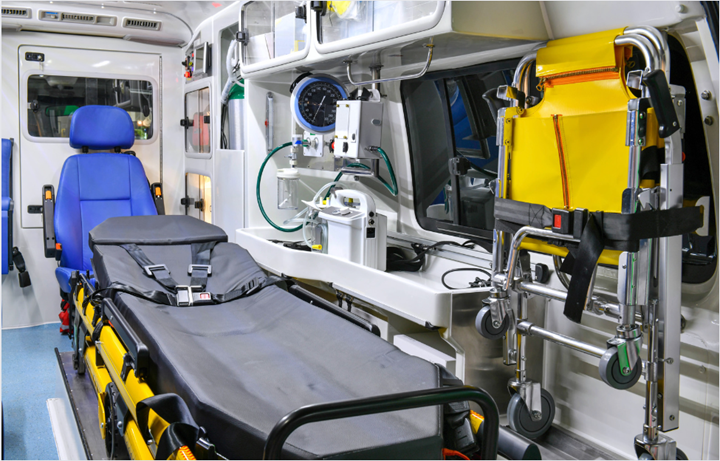Ambulance Mount Failure:
Improper Installation Increases Patient Injury

John R. Yannaccone, P.E., Principal Mechanical Engineer

Case Summary: An ambulance service and their driver were named in a lawsuit following a crash that injured the patient being transported. The driver lost control of the vehicle, which subsequently impacted a tree. Following the crash, the patient was found partially off the top of the stretcher, with the straps still across their body, and suffered a severe head injury. The stretcher dislodged from the floor of the ambulance, shifting several feet forward.
While it was agreed that the crash was caused by the ambulance’s excessive speed, the ambulance service wanted to understand the factors that contributed to the patient’s injuries. To that end, DJS’ mechanical engineers were retained to inspect the physical evidence and provide a report.
Expert Analysis: Inspection of the ambulance showed damage consistent with the reported frontal impact. The stretcher was equipped with five straps to secure the patient to the gurney; three which crossed the body and two shoulder straps. Physical evidence of loading on the straps and gurney indicated all five straps were in use at the time of the crash. While the stretcher was generally intact with minor deformations, the bracket attaching the forward end of the stretcher to the floor of the ambulance had separated from the floor. Loss of this forward attachment allowed the stretcher to move forward and release from the rear attachment point, leaving it unsecured.
Additional inspection of the forward bracket’s attachment showed it had been bolted through the plywood floor and sheet metal skin of the ambulance. It was not fastened to the structure of the ambulance box or the vehicle chassis. The floor bracket’s installation instructions indicated that bolting it to a structural member was the preferred attachment method and included information on the minimum size requirements of that member. The instructions also provided an alternative option to install the bracket using a backing plate to distribute the loads over a larger area, rather than attaching to a structural member.
The ambulance manufacturer had not used either of the allowable methods of attachment, opting to only fasten the bracket to the non-structural floor. This method did not provide sufficient strength to transfer the gurney and patient loads to the ambulance structure. The bracket separated from the ambulance and allowed the gurney to move forward during the crash.
Due to the improper attachment and installation of the bracket, the patient was exposed to hazards beyond what would have been present had the stretcher remained attached and in-place. Had the gurney remained attached to the floor, it is unlikely the patient’s head would have impacted the ambulance interior and potentially resulted in less severe injuries.
Result: Due to the failure of the ambulance manufacturer to properly install the floor brackets, the ambulance service joined them as a third party in the case. The case settled prior to trial.
Categories: John R. Yannaccone, P.E. | Mechanical Engineering | Principal Mechanical EngineerTags: Ambulance | Equipment Failure | Floor Brackets | Improper Installation | Manufacturer Liability


